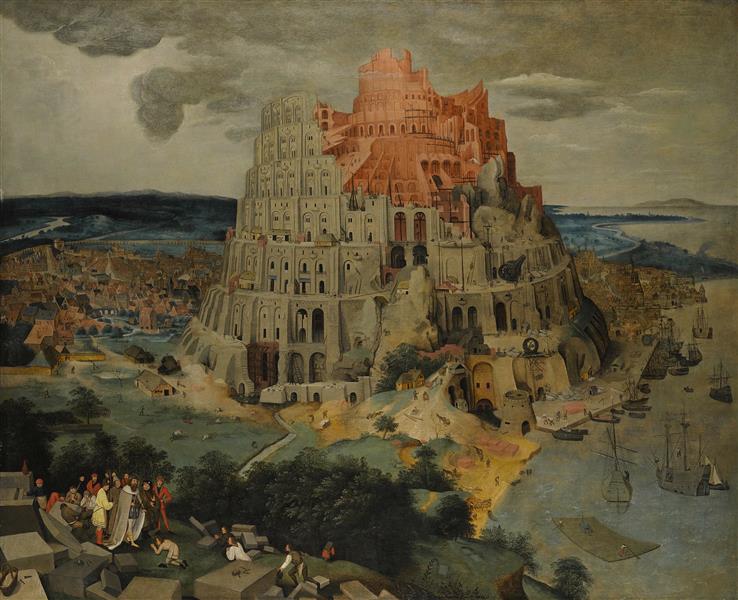תיאור
הציור "לה טורה דה בבל", המיוחס לפיטר ברויגל הצעיר, הוא פרשנות מחודשת מרתקת של אחד הנושאים הסמלים ביותר של אמנות הרנסנס, שבה טופל במקור על ידי אביו, פיטר ברויגל אל וויג'ו. יצירה זו, שנמצאת בהקשר של הקלאסיקה של המאה ה -16, מציגה סיפור חזותי מורכב שמזמין השתקפות עמוקה על השאיפה והמצב האנושי.
הרכב היצירה הוא, בעצם, מונומנטלי. הבד נשלט על ידי המגדל המרשים והמסיבי העולה במרכז, ומסמל את השאיפה המופרזת של האנושות כלפי האלוהי. המבנה מאופיין בעיצוב אדריכלי מורחב, עם מטוסים מפוארים החופפים זה את זה, לוכדים את רוח ההנדסה ובניית הזמן. ברויגל הצעיר, למרות שהוא שחזר את מושג אביו, משרה את חזונו שלו ביצירה, ואולי משקף פרשנות אופטימית או מורכבת יותר של ההיסטוריה המקראית.
הצבע ממלא תפקיד חיוני בציור זה, עם פלטה הנשלטת על ידי גוונים נוראים וניגודים חמים באופן סובדני המעוררים תחושה של מונומנטליות וחלודה. הגוונים הכחולים באופק שזורים זה בזה באוקר ובחום של המגדל, ויוצרים איזון חזותי שמושך את תשומת ליבו של הצופה לעליית הבנייה. הבחירה בצבעים לא רק נותנת חיים למגדל, אלא גם מרמזת על תחושת אטימות ושיאה, כאילו השאיפה האנושית תמיד הייתה בקצה להגיע לגן עדן, עם זאת, ללא הרף.
באשר לדמויות, היצירה מציגה בגאווה המון דמויות אנושיות - מאמרים, עובדים ואדריכלים - מפוזרים בבסיס המגדל ובכל רמותיהם. דמויות אלה מספקות תחושת קנה מידה ותנועה, תוך הדגשת רעיון שיתוף הפעולה והמאמץ האנושי במימוש פרויקט ענק. ביטויים של העובדים נראים משולבים בין השריכות לשלווה, ומציעים סוג של התפטרות לגרנדיוזיות של המטרה שהם רודפים, ומעוררים דיאלוג על הקשר בין המאמץ האנושי לגבולותיו.
מעניין לציין כי יצירה זו אינה מוגבלת להיות עותק גרידא של יצירתו המקורית של אביו, אלא ניתן לראות גם בהקשר הרחב יותר של אמנות פלמנקו והתפתחותה. במובן זה, הנושאים החוזרים ונשנים של היצירה משקפים את הדאגות החברתיות והדתיות באותה תקופה, כולל מושגי הגאווה, האחדות והפיזור הסופי של האנושות, כפי שמסופר בהיסטוריה המקראית של באבל. בנוסף, ייצוג זה השפיע על אמנים אחרים במשך מאות שנים, והפך לאייקון תרבותי שהתפרש מחדש בצורות שונות.
מורשתו של ברויגל נעוצה ביכולתו לתפוס לא רק את המהות הוויזואלית של אמנות זמנו, אלא גם ביכולתו להחדיר משמעות בכל מכת מברשת. "מגדל בבל" הופך אפוא לנקודת מפגש בין היסטוריה, מוסר ואמנות, מהדהד עם חוקרים וצופים עכשוויים המבקשים להבין את המורכבות של השאיפה האנושית. בסופו של דבר, ציור זה הוא עדות של כושר ההמצאה והאמונה של אנושיות, שבאמצעות בנייה ושיתוף פעולה מבקשת להשיג את הבלתי אפשרי, ההשתקפות וההתרעה של הסכנות בגאווה וחלוקה.
KUADROS ©, צבע מפורסם על הקיר שלך.
ציורי שמן בעבודת יד, עם איכות אמנים מקצועיים וחותם ייחודי של KUADROS ©.
שירות רבייה בתמונות עם ערבות שביעות רצון. אם אינך מרוצה לחלוטין מהעתק הציור שלך, אנו מחזירים את הכסף שלך 100%.

